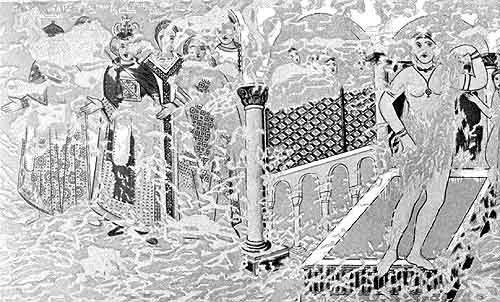
| Court art of Sogdian Samarqand in the 7th century AD | |||||||||||||
| Home | General | Western Wall | Northern Wall | Eastern Wall | Southern Wall | Bibliography | |||||||
 |
|
|||||||||||||||||||||||||||||||||||||||||||
Although the Afrasiab conception of four directions with China in the north seems to be a unique artistic formula, the general idea is an old one and widespread in mythology as well as in art.
A singular textual parallel may be seen in Mani's Kephalaia. There are mentioned "four kingdoms of the world", i.e. Babylon and the Persis, Rome, Axum, and (perhaps) China. Although no explicite directional order is given, in this set China should clearly belong to the north.
If we concentrate - more or less - on the time level of the paintings, similarities can be found in Sogdian paintings at Pandhikent. The parallel to Afrasiab we have mentioned already in our 1993 publication. It has been adopted recently by B. I. Maršak [2001], too. But the similarities are merely superficial because they lack any connection with state ideology. Still one may conclude a certain Sogdian-based originality of such formulae.
An interesting parallel to the Chinese account of Kushaniyah was already drawn when original Sogdian paintings were not yet known. H. H. Schaeder [1934] pointed to a famous Umayyad wall painting in Qusayr 'Amra (Jordan, 8th century). The much disputed mural depicts "the kings of the world" or, as others prefer to say, "the enemies of Islam":

Above: Mural from Qusayr 'Amra (copy); the scene in question covers the left half. [ Image after Strzygowski, J.: Asiens bildende Kunst in Stichproben, ihr Wesen und ihre Entwicklung - Augsburg 1930, ill. 580 ].
At the time the Umayyad painting was created, artistic influences from Central Asia reached the Near East, too. But Qusayr 'Amra belongs to a completely different artistic environment, much of it is inspired by Byzantine art. Concerning the symbolic background, some scholars have pointed to Sasanian roots. Unfortunately, nothing the like survived, and the mural from Jordan remains as unique as the Afrasiab paintings.
 |
|
|||||||||||||||||||||||||||||||||||||||||||